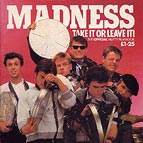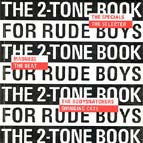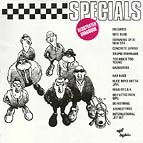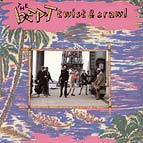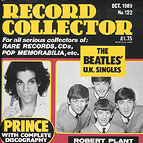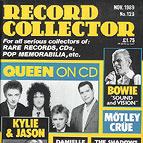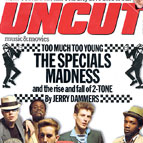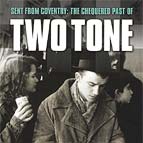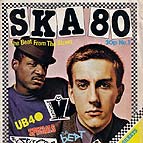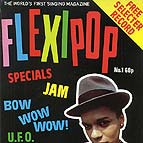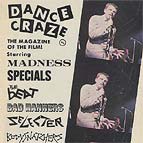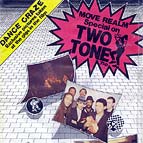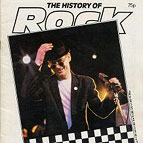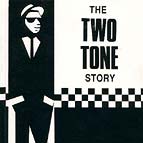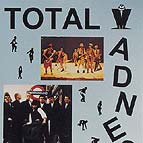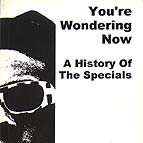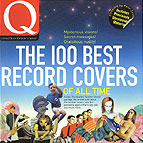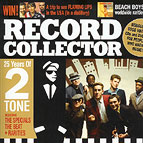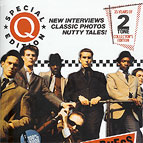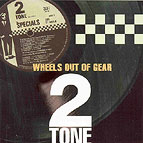 |
 |
|||||||||||||||||
By 1981 2 Tone was in an obvious state of decline but for some reason this year was the most productive in terms of publications based on or around the label. Dance Craze was released to rather lukewarm reviews, but this didnt deter both Sounds and Movie Realm from each producing a magazine to accompany the films release. The Sounds publication, written by then Features Editor, Garry Bushell, is by far the most informative and appealing of the two. Bushell was a fan on 2 Tone from the very beginning, as his accompanying text for each of the bands featured in the film proves. The Movie Realm magazine is by contrast, very poor in effort indeed. It is more or less a collection of film stills plus a few photographs of fans thrown in, and had the air of a quick cash-in about it.
The combination of a black and white colour scheme and inconsistent text layout makes for a very confusing read indeed. Much easier on the eye is the Specials Illustrated Songbook, which as the titled suggests is a collection of the Specials catalogue complete with amusing and highly original cartoon artwork. Again published in 1981 it is highly sought after by collectors and is well worth tracking down. 1981 also saw a biography of The Beat titled Twist and Crawl. Published by Omnibus, who brought us the 2-Tone Book For Rude Boys, it offers a detailed account of the band's history as well as a few photographs. Not the most essential of publications but worth getting hold of. In 1984 a series of magazines titled the History of Rock published an issue dedicated to 2 Tone, titled Shall We Dance. Its basically a collection of photos and text on all the usual suspects, although for reasons best known to the editor the final page features ZZ Top... Although books on 2 Tone have been rather sporadic over the years, no publisher has been more consistent in his writing on the subject than George Marshall and his ST Publishing set up. From his beginnings as a fanzine writer, with titles such as Zoot, Skinhead Times and Pulped, he has written and published books which offer excellent insights into both the label and associated bands. The Two Tone Story is perhaps his best known publication. From a humble A5 photocopy and staples effort to inclusion in with an 'official' 2 Tone release, via The Compact 2 Tone Story, the book offers perhaps the best account of the rise and subsequent fall of the label. Another title by the same author is Total Madness, which (despite it's dodgy cover) is again up to his usual high standards and offers a detailed account of the rise of Camdens finest. The first 1000 copies of Total Madness were accompanied by an A5 biography of Bad Manners (again by George Marshall), which also should be of interest to collectors of 2 Tone. ST Publishing also released Youre Wondering Now A History of The Specials by Paul Williams. This book along with The Two Tone Story offer an excellent grounding on 2 Tone and are essential purchases for any collector of the label. Its obvious that both Paul Williams and George Marshal are fans of 2 Tone but they retain the ability to write objectively about both the labels hits and misses. In 1989 the label's 10th anniversary was marked by Record Collector featuring the back catalogue across two issues, in October and November. Quite why it was decided to spread the discography across two issues is a bit of a mystery given that in total the feature takes up nine pages some of which are half shared with ads. Record Collector No.122 takes us from Gangsters to Do Nothing, with Record Collector No.123 continuing from Dance Craze to The 2 Tone Story compilation in '89. 1998 saw Uncut Magazine dedicate a huge section of its July edition to the chequered label. The normally media shy Mr Dammers was interviewed extensively for the issue and offered some interesting insights to the label. Also featured are interviews with Rhoda Dakar and Terry Hall who seem to have less than favourable memories of their time with the label. |
By 1980 the nation was feeling the full effect of 2 Tones popularity and two publications appeared on the market which were of interest to fans. One was the imaginatively titled SKA80 and the other was the first issue of what was subtitled the worlds first singing magazine, Flexipop. Both were rather childish affairs, with Flexipop featuring those embarrassing photo-story-lines, which were inflicted on the nations youth during the 70s and early 80s. For the collector this edition is worth tracking down if it comes complete with the free flexi-disc. The recording is of a remix of On My Radio, which was, and still is, unavailable elsewhere. SKA80 is worth picking up simply because it failed to make it beyond the initial issue, but in terms of what was readily available in the music weeklies of the time, it offers very little insight to the bands or 2 Tone itself.
1981 also saw the release of another film, which was of interest to fans of 2 Tone. Madness had produced a rather amateurish, but it has to be said endearing, account of the bands progress up until the release of their first single, The Prince. To accompany the release of the film, titled Take It or Leave It, a magazine of the same name was released complete with a free flexi-disc.
Perhaps worth a brief mention is Q Magazine's 100 Best Record Covers Of All Time issued in 2001, though only a two page mention of 2 Tone, in it Dammers gives a candid account of how the design came about, how he is still annoyed by the 2 Tone logo on the die-cut company sleeves, and even has a pic of the famous Walt Jabsco bowling shirt... 2004 saw the 25th anniversary of the formation of the label so that it was only fitting that a few more publications would be released. First of the mark was Richard Eddingtons book Sent to Coventry: The Chequered Past of Two Tone. Despite a great introduction by Mark Bedford from Madness and setting the scene very well in a pre-2 Tone Coventry the book goes steadily downhill from there and is only made worse by the author rather desperate attempt to somehow involve himself in the 2 Tone story. The serious side of record collecting also recognised 2 Tone's anniversary by way of a large feature Record Collector No.300 August edition. The magazine had featured 2 Tone in two previous consecutive editions in 1989 but this was by far the most in-depth approach it had taken to the label. Q Magazine also released a 2 Tone edition as part of its Q Special Edition series. Previous editions had featured Specials on the likes of Punk and The Who and this edition was up to the usual standards. As well as offering some desperately needed new interviews with ex-band members; the magazine includes some great photographs from way back in the day. And as 2004 was about to end serial music journalist Dave Thompson released the bizarrely titled Wheels out of Gear: 2 Tone The Specials and a World in Flame. More of a social history of the period 1979 81 than the story of 2 Tone, it does offer a good insight to the rise of Margaret Thatcher and the general state of Britain at the time. For those who can remember the Thatcher Years (and are perhaps trying to forget them) the book does offer a timely reminder of not only of the racial division, but also the social divisions which accompanied Thatchers rise to power. As good as this aspect of the book may be the actual percentage of the book relating to 2 Tone is very low indeed. Its very much a basic retelling of the labels history and offers absolutely nothing new to the reader. Overall very misleading given the books title and cover graphics and is far from an essential purchase. |
|||||||||||||||||||||
